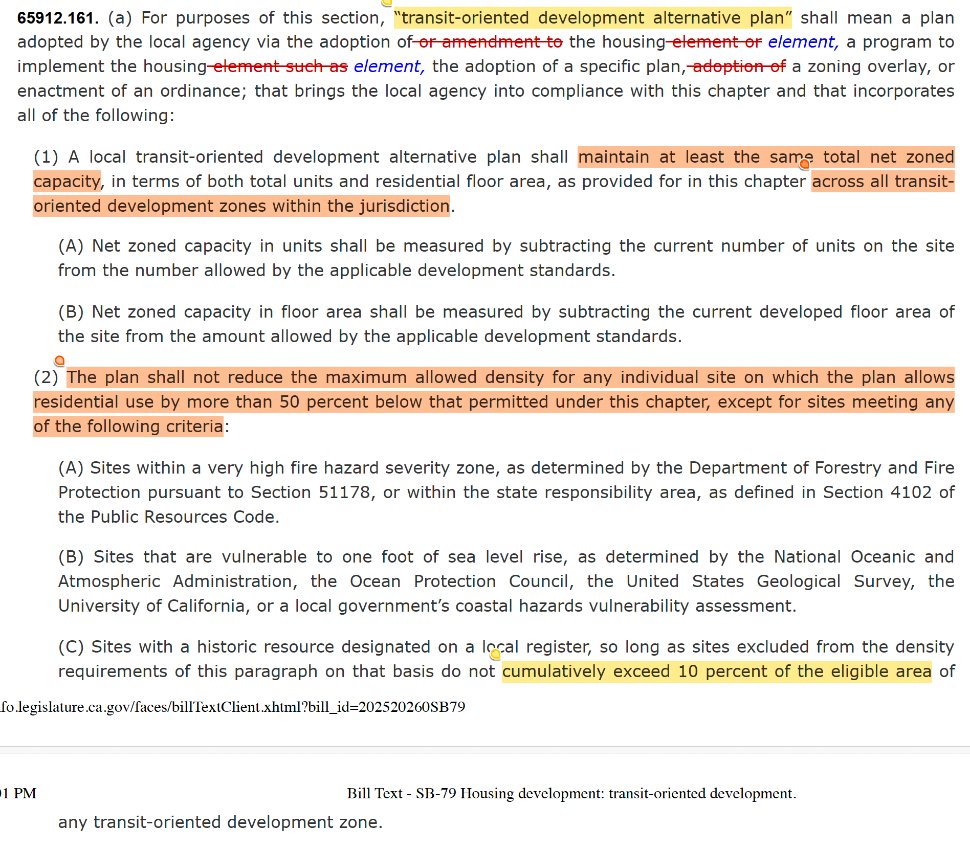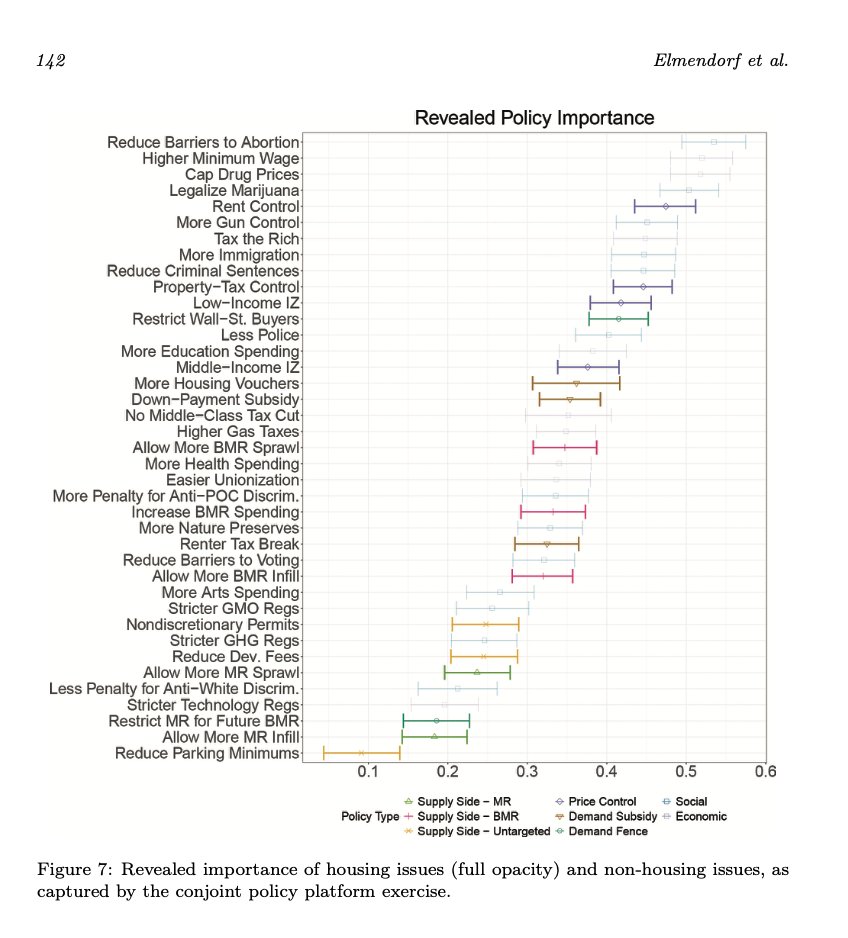SB 79 Thread #1: Big Picture
In the fall of 2018, I first met @hanlonbt. I had recently posted "Beyond the Double Veto". He reached out & suggested we get coffee.
We argued about SB 827 (SB 79's oldest ancestor), which had died the previous winter.
1/24
In the fall of 2018, I first met @hanlonbt. I had recently posted "Beyond the Double Veto". He reached out & suggested we get coffee.
We argued about SB 827 (SB 79's oldest ancestor), which had died the previous winter.
1/24
https://twitter.com/CSElmendorf/status/1966910007141867675
I was skeptical.
I said, "Even if you manage to pass an SB 827 successor, it'll be like ADU law circa 1982. Local govs will destroy the projects w/ conditions of approval & CEQA."
He replied, "Have you seen what we did with the Housing Accountability Act?!"
/2
I said, "Even if you manage to pass an SB 827 successor, it'll be like ADU law circa 1982. Local govs will destroy the projects w/ conditions of approval & CEQA."
He replied, "Have you seen what we did with the Housing Accountability Act?!"
/2
"Yeah," I answered, "your HAA reforms are great! Even so, they don't stop discretionary conditions of approval or CEQA. If I were in your shoes, I'd focus on strengthening the Housing Element Law. It's dumb in lots of ways, but it gets one essential thing right."
/3
/3
me: "It lets cities plan for new housing where there's the least local resistance. And it recognizes that constraints on development are substitutes, and that there more ways to kill a project than we can even imagine.
So you need a state agency that can assess...
/4
So you need a state agency that can assess...
/4
the cumulative effect of local constraints & knock out new ones as they arise."
(An agency that operates, as @ezraklein & @DKThomp might say, as both a "bottleneck detective" and a bottlebrush.)
/5
(An agency that operates, as @ezraklein & @DKThomp might say, as both a "bottleneck detective" and a bottlebrush.)
/5
Brian: "That's fine in theory, but HCD hasn't gotten the job done w/ housing elements. Why expect better in the future?"
me: "The Leg should strengthen HCD's authority & bolster its staff. It needs economists & former for-profit developers on staff too."
/6
me: "The Leg should strengthen HCD's authority & bolster its staff. It needs economists & former for-profit developers on staff too."
/6
Fast forward to 2025: SB 79, the winning successor to SB 827, is a fascinating synthesis of "Hanlon thought" & "Elmendorf thought" circa 2018, with a healthy dose of @ProfSchleich & @RickHills2's thinking too.
/7
/7
SB 79 carries forward the original SB 827 idea of defining heights & floor-to-area ratios that cities must allow near transit. ("Hanlon thought")
/8
/8
But it pairs this idea with far more robust protections against local evasion, while also giving cities flexibility to accommodate local political exigencies. Supervising it all will be ... @California_HCD. ("Elmendorf thought")
/9
/9
What are those protections against evasion?
- 1. There's a pathway to ministerial review! If developer sets aside 10% of units for very low income households, they may opt into SB 35/423 streamlining, ***regardless of city's progress toward RHNA.***
/10
- 1. There's a pathway to ministerial review! If developer sets aside 10% of units for very low income households, they may opt into SB 35/423 streamlining, ***regardless of city's progress toward RHNA.***
/10

- 2. If city wrongly disapproves a SB 79 project, it faces not only the usual HAA remedies (fee-shifting, etc.), but, in high-resource areas, mandatory fines of $10k+/unit. Fines will likely be higher if city has prior HAA violations or is found by court to be in bad faith.
/11


/11



- 3. SB 79 borrows key language from Density Bonus Law, barring cities from applying any combination of regs that "physically preclude" project of authorized scale. SDBL case law interprets this phrase to protect project amenities that developer wants to provide. Big!
/12
/12

- 4. SB 79 authorizes cities to impose local standards" (including IZ) that do not, "alone or in concert, prevent achieving" the height, FAR, & density allowed by SB 79. This language is new and untested, but...
/13
/13

it *might* be interpreted as a financial-feasibility limitation on local zoning & development standards as-applied to SB 79 projects. (hang tight)
- 5. SB 79 bars local development standards that discriminate against SB 79 projects (as opposed to generally applicable rules)
/14
- 5. SB 79 bars local development standards that discriminate against SB 79 projects (as opposed to generally applicable rules)
/14

- 6. Above all, SB 79 puts HCD in driver's seat. HCD decides how SB 79 capacity counts toward RHNA. HCD reviews local implementation / flexibility plans & determines whether they're compliant. And...
/15


/15



starting in 7th cycle, it appears that local govs *will not be allowed to adopt a flex plan* unless HCD has determined that it "substantially complies" w/ SB 79.
(statutory text isn't as clear on this point as I would like)
/16
(statutory text isn't as clear on this point as I would like)
/16

The substance of the local flexibility plan proviso is elegant too.
It's a "zoning budget" a la @ProfSchleich & @RickHills2 (city may reallocate but not reduce SB 79 capacity), w/ additional "landmark budget" (city may landmark <= 10% of area), & ...
/17

It's a "zoning budget" a la @ProfSchleich & @RickHills2 (city may reallocate but not reduce SB 79 capacity), w/ additional "landmark budget" (city may landmark <= 10% of area), & ...
/17


bounds on how much capacity may be added to or removed from a site. (City may double a site's SB 79 capacity, or halve it, but can't escape SB 79 by zoning for a few skyscrapers.)
Sites at risk of wildfire or sea rise, or designated historic, are exempt from lower bound.
/18
Sites at risk of wildfire or sea rise, or designated historic, are exempt from lower bound.
/18
Sen. Wiener did have to make some serious concessions to get SB 79 across finish line, including:
- unfunded BMR unit requirements + authorization for more local unfunded IZ
- exclusion of sites that had rent-controlled units w/o last 7 years
/19
- unfunded BMR unit requirements + authorization for more local unfunded IZ
- exclusion of sites that had rent-controlled units w/o last 7 years
/19
https://x.com/CSElmendorf/status/1943176346697667063
- explicit permission for local govs to apply "any local demolition and antidisplacement standards" to SB 79-eligible parcels
- eliminating from bill's coverage "Tier 3" transit & all but a handful of urban counties (no SB 79 for Davis, alas!)
/20
- eliminating from bill's coverage "Tier 3" transit & all but a handful of urban counties (no SB 79 for Davis, alas!)
/20

I am extremely worried about the savings clause for local demo & displacement standards.
What's to keep a city from banning any demo of any existing structure?
(I'll suggest some answers in the coming 🧵on legal Qs, but suffice it to say, there's not an easy answer)
/21
What's to keep a city from banning any demo of any existing structure?
(I'll suggest some answers in the coming 🧵on legal Qs, but suffice it to say, there's not an easy answer)
/21
To wrap up: SB 79, though far from perfect, is an incredible achievement.
It was voted out of its first committee hearing over the objection of chair, a rarity.
It cleared *every single one* of its committee & floor votes w/o a single vote to spare.
/22
It was voted out of its first committee hearing over the objection of chair, a rarity.
It cleared *every single one* of its committee & floor votes w/o a single vote to spare.
/22
And the chair of Senate Housing, who opposed the bill initially & was pilloried by many (including me), ultimately voted to concur in Assembly's passage of the bill.
Her vote on the last day of the legislative session was SB 79's margin of victory.
/23
Her vote on the last day of the legislative session was SB 79's margin of victory.
/23
https://x.com/CSElmendorf/status/1966625783730098476
Substantively, SB 79's integration of "Hanlon thought," "Hills & Schleicher thought" and "Elmendorf thought" amounts to a very promising foundation for the administrative, legislative & judicial tinkering that will no doubt be necessary to realize the bill's great promise.
/end
/end
• • •
Missing some Tweet in this thread? You can try to
force a refresh











